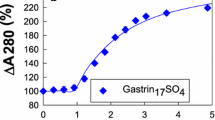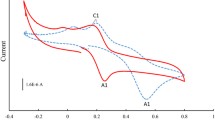Abstract
The reaction of the β subunit of murine nerve growth factor (NGF) with diethylpyrocarbonate (DEP) results in the quantitative modification of histidine residues and the loss of binding to rabbit superior cervical ganglia microsomes. No conformational changes accompanied the conversion as judged by fluorescence spectra. Hydroxylamine converted the carbethoxy derivatives back to the unmodified imidazoles and simultaneously restored the capacity of NGF to bind to its receptor. Modification of des (1–9) NGF, from which His-4 and His-8 have been quantitatively removed, results in the same loss in binding activity, suggesting that His-75 and/or His-84 may play an important role in hormone-receptor interactions.
Similar content being viewed by others
References
Angeletti, R. H., and Bradshaw, R. A. (1972).Proc. Natl. Acad. Sci. USA 68, 2417–2420.
Banerjee, S. P., Snyder, S. H., Cuatrecasas, P., and Greene, L. A. (1973).Proc. Natl. Acad. Sci. USA 9, 2519–2523.
Bocchini, V. and Angeletti, P. U. (1969).Proc. Natl. Acad. Sci. USA 64, 787–794.
Bradford, M. (1976).Anal. Biochem. 72, 248–254.
Bradshaw, R. A. (1978).Annu. Rev. Biochem. 47, 191–216.
Bradshaw, R. A., and Niall, H. D. (1978).Trends Biochem. Sci. 3, 274–278.
Bradshaw, R. A., Jeng, I., Andres, R. Y., Pulliam, M. W., Silverman, R. E., Rubin, J., and Jacobs, J. W. (1977). InEndrocrinology (James, V. H. T., ed.), Exerpta Medica, Amsterdam, Vol. 2, pp. 206–212.
Cohen, P., Sutter, A., Landreth, G., Zimmermann, A., and Shooter, E. M. (1980).J. Biol. Chem. 255, 2949–2954.
Fontana, A. (1972).Meth. Enzymol. 25, 419–423.
Frazier, W. A., Angeletti, R. H. and Bradshaw, R. A. (1972).Science 176, 482–488.
Frazier, W. A., Hogue-Angeletti, R. A., Sherman, R., and Bradshaw, R. A. (1973).Biochemistry 12, 3281–3293.
Harper, G. P., and Thoenen, H. (1981).Annu. Rev. Pharmacol. Toxicol. 21, 205–229.
Jeng, I., and Bradshaw, R. A. (1978). InResearch Methods in Neurochemistry (Marks, N., and Rodnight, R., eds.), Plenum Press, New York, Vol. 4, pp. 265–288.
Komoriya, A., Hortsch, M., Meyters, C., Smith, M., Kanety, H., and Schlessinger, J. (1984).Proc. Natl. Acad. Sci. USA 81, 1351–1355.
Levi, A., Schechter, Y., Neufeld, G. J., and Schlessinger, J. (1980).Proc. Natl. Acad. Sci. USA 77, 3469–3473.
Miles, E. W. (1977).Meth. Enzymol. 47, 431–442.
Pullen, R. A., Lindsay, D. G., Wood, S. P., Tickle, I. J., Blundell, T. L., Wollmer, A., Krail, G., Brandenburg, D., Zahn, H., Gliemann, J. and Gammeltoft, S. (1976).Nature 259, 369–373.
Pulliam, M. W., Boyd, L. F., Baglan, N. C., and Bradshaw, R. A. (1975).Biochem. Biophys. Res. Commun. 67, 1281–1289.
Server, A. C., and Shooter, E. M. (1977).Adv. Protein Chem. 31, 339–409.
Stach, R., and Shooter, E. M. (1974).J. Biol. Chem. 249, 6668–6674.
Sutter, A., Riopelle, R. J., Harris-Warrick, R. M., and Shooter, E. M. (1979).J. Biol. Chem. 254, 5972–5982.
Tait, J. F., Weinman, S. A., and Bradshaw, R. A. (1981).J. Biol. Chem. 256, 11086–11092.
Thomas, K. A., Silverman, R. E., Jeng, I., Baglan, N. C., and Bradshaw, R. A. (1981).J. Biol. Chem. 256, 9147–9155.
Author information
Authors and Affiliations
Rights and permissions
About this article
Cite this article
Dunbar, J.C., Tregear, G.W. & Bradshaw, R.A. Histidine residue modification inhibits binding of murine β nerve growth factor to its receptor. J Protein Chem 3, 349–356 (1984). https://doi.org/10.1007/BF01025171
Received:
Published:
Issue Date:
DOI: https://doi.org/10.1007/BF01025171




